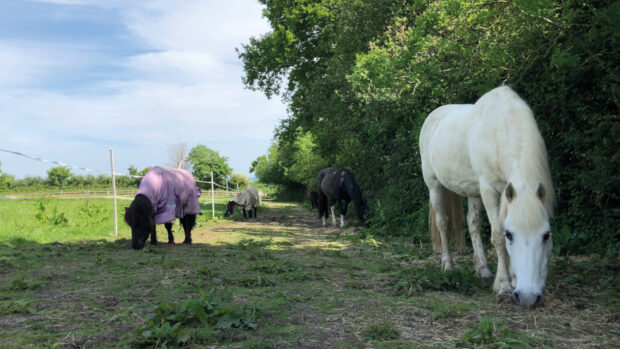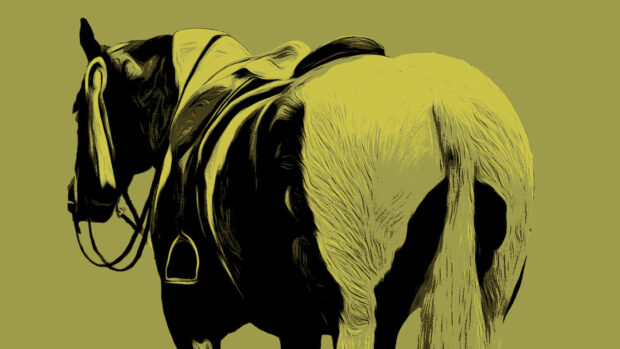Anyone who has owned a native pony will be familiar with its ability to create fat out of thin air, and with the difficulties in management this causes. Now at last, as a result of work done at the University of Missouri, a condition called Equine Metabolic Syndrome (EMS) has been recognised.
This condition may explain why domesticated ponies are so prone to obesity and laminitis, and is possibly the result of evolutionary developments that enable native breeds to survive harsh weather and food shortages.
In the wild, ponies are programmed to put on weight during the relatively lush summer and autumn months, with fat (stores of energy) distributed around the body in preparation for leaner times. Significantly, fat is preferentially laid down in the abdomen, where it is known as omental fat.
Until recently, it was thought that these fat cells (known as adipocytes) were just benign stores of energy. But research has shown that adipocytes are in fact active and can produce a variety of hormones known as adipokines. These help control and regulate a number of body processes and are programmed towards enhancing our native ponies’ ability to endure periods of environmental harshness.
It appears that the omental adipocytes produce an especially significant range of adipokines that, among other things, generate an increase in the level of circulating cortisol. This steroid is instrumental in inhibiting the action of the hormone insulin (which controls blood glucose levels), and results in insulin resistance and a degree of hyperglycaemia.
In relatively fat ponies entering the winter months, this insulin resistance has a physiological benefit. It preserves and prioritises glucose (and therefore energy) for essential areas such as the brain, at the expense of non-essential tissues like muscle.
As the pony gradually loses weight during the winter, so the level of omental fat reduces and the state of insulin resistance becomes reversed. Eventually, spring arrives and the pony is in a lean but healthy condition — ready to indulge safely in the pleasures of rich grazing.
Unfortunately, this system has become unbalanced as a result of domestication. It has meant that the average equine diet is too rich and too plentiful. Grain-based feeds tend to be the main culprit, but even hay and other forages are now made from improved pastures and so have a high nutritional value.
Many ponies enter the winter in an over-fat state and maintain this level of condition, so the state of insulin resistance is not reversed. Long-term insulin resistance has various undesirable consequences, which include chronic hypoglycaemia and hyperinsulinaemia (high blood glucose and insulin levels respectively). Ultimately, a condition of glucotoxicity (too much sugar) arises and this significantly increases the risks of laminitis developing.
“Metabolic syndrome” has been used to describe this scenario. It is well recognised in humans, where there is a very obvious link between obesity and cardio-vascular disease. Human glucotoxicity causes an increase in blood pressure (hypertension), which predisposes to coronary disease — and also insulin-dependent diabetes mellitus (due to the exhaustion of the pancreas’s insulin-secreting abilities).
It is thought that hypertension in ponies could predispose them to laminitis rather than heart disease — and a state of diabetes mellitus is recognised but tends to be insulin-dependent because there is no evidence that the pancreas becomes exhausted.
EMS has many characteristics similar to Cushing’s disease, which is why it has often been termed “peripheral Cushing’s disease”. However, this is misleading because there is nothing wrong with the pituitary or adrenal glands in cases of EMS, as there is with Cushing’s.
Referring to it as the “laminitis-hypothyroidism syndrome” is also inaccurate because there is no evidence of any thyroid malfunction. Other names include “obesity-related laminitis”, “equine syndrome X” and “insulin resistance syndrome” — but EMS is
now universally preferred.
EMS can be difficult to recognise because the signs are often very subtle and it can be confused with Cushing’s or even hyperthyroidism. In general, EMS is seen in ponies, cobs and warmbloods under 15 years of age, whereas Cushing’s tends to affect older equines of any age.
Common signs of EMS
- Obese adult horse (although a minority may be normal sized)
- Abnormal body fat distribution, eg thickened, cresty neck; excess fat around head of tail; fatty shoulders; flabby, fatty sheath; pot-bellied look
- “Good doer” who puts on weight easily and loses it with great difficulty
- Unexplained laminitis that may be obvious and severe or very subtle, eg abnormal hoof growth; laminitic rings on hoof wall and expansion of white line with no apparent lameness
- Ravenously hungry all the time
- Urinating frequently
- Lethargic and lazy
- Infertile or abnormal cycles in mares
There is no one test for EMS. Raised blood glucose is strongly suggestive, especially if the animal is under the age of 15 and showing some of the signs listed. Occasionally, ultrasonography can be helpful in assessing levels of omental fat.
Often, a diagnosis of EMS is made only after elimination of similar conditions such as Cushing’s and hyperthyroidism (overproduction of thyroid hormones) from blood tests, for example, glucose tolerance and dexamethasone suppression tests.
Various forms of treatment have been tried, based upon products that influence the pituitary and/or adrenal glands. But there is little rationale behind this because in EMS the pituitary and adrenal glands function normally. The results of trials have been inconclusive so far.
Similarly, the reasoning behind the practice of thyroid supplementation for EMS, which is popular in the USA, is weak because these animals are not hypothyroid. It may be that it helps simply because it encourages weight loss.
By far the most important aspect of controlling EMS is a combination of diet and exercise. A diet high in fibre and based on hay, non-molassed sugar beet and commercial products such as HiFi Lite is “good”. Sadly, grass, cereals and succulents such as apples and carrots are “bad”. Supplements containing antioxidants, chromium and magnesium claim to be of help (possibly by increasing insulin sensitivity), but more work needs to be done here.
Exercise is essential — not only does it encourage a loss in omental fat, but it also promotes an increase in glucose uptake. Work has shown that a fit pony (even if slightly overweight) will have an increased sensitivity to insulin and will lose weight faster than an unfit animal.



